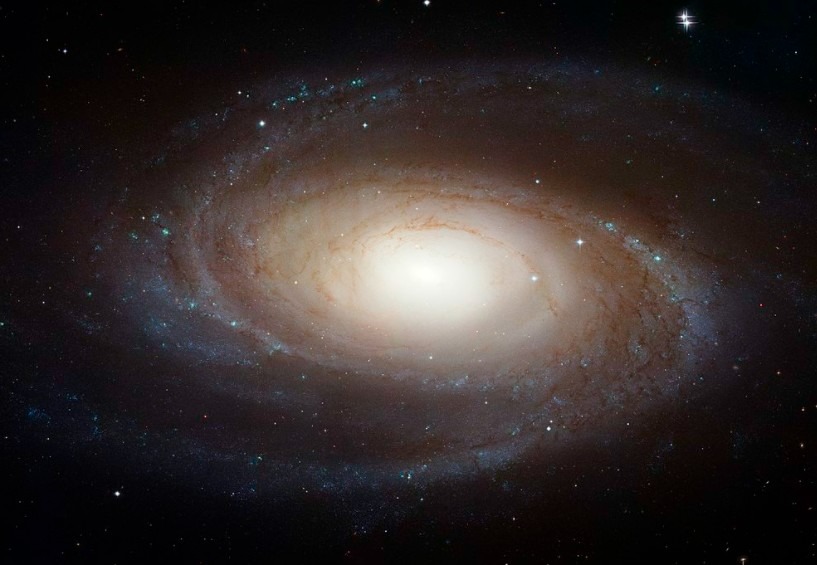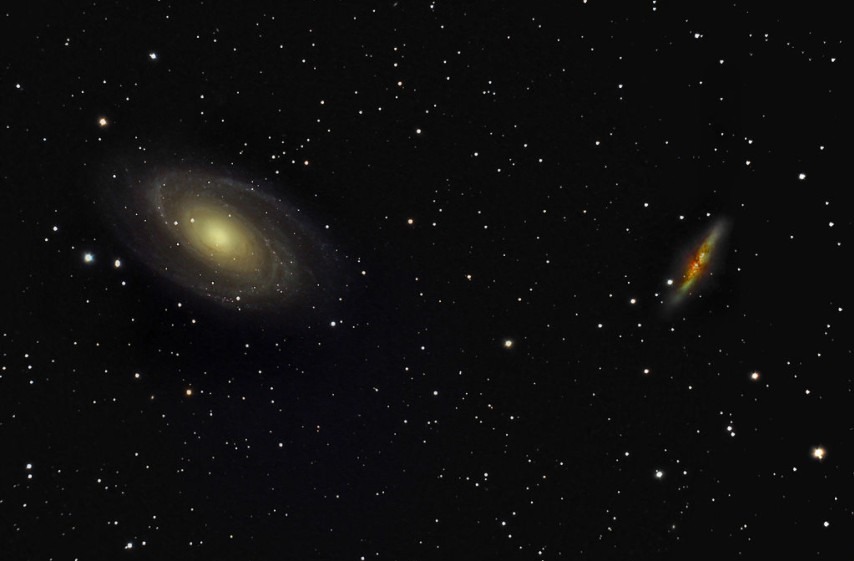Located 12 million light-years from Earth in the constellation Ursa Major, Messier 81 is one of the brightest galaxies in the night sky. Messier 81 was discovered along with the nearby Cigar Galaxy (Messier 82) by the German astronomer Johann Elert Bode on December 31, 1774. It has an apparent magnitude of 6.94.
The spiral arms of the galaxy Messier 81 are made up of young, bluish, hot stars formed in the past few million years wind all the way down into its nucleus. M81 is dusty and interstellar dust is found in its spiral arms, and they connect to the star formation areas. In star formation areas, the hot blue stars heat the dust that results in the hot dust to emit infrared energy from these areas. Messier 81 It is home to a population of stars formed in a formation that took place about 600 million years ago. Ultraviolet light from hot, young stars is fluorescing the surrounding clouds of hydrogen gas. Several sinuous dust lanes also wind into the nucleus of M81.
With a pair of binoculars, you will enjoy watching the faint patch of light in the same field of view as Messier 82. A small telescope will help you locate M81’s core. The galaxy is best observed during April.
The bulge at the center of the galaxy, significantly more extensive than that of the Milky Way, contains much redder and much older stars. A black hole of 70 million solar masses lies at the center of M81 and is about 15 times the mass of the Milky Way’s central black hole. Previous Hubble research showed that the black hole’s size in a galaxy’s nucleus is proportional to the galaxy’s bulge’s mass.
Messier 81 galaxy names include Bode’s Galaxy and NGC 3031, Its designation in the New General Catalogue. The active nucleus, or referred to as the black hole, is a natural attraction for scientists and professional astronomers studying what is really in there that makes the galaxy very large and very bright. Similarly, amateur astronomers are also enticed to look at it.
After the discovery of Johann Bode of the M81 galaxy in 1774, Pierre Mechain also found both galaxies independently in August 1779 and reported the discovery to Charles Messier, who added them to the Messier catalog as M81 and M82 on February 9, 1781.
VISIBILITY
From the Earth, Messier 81 is tilted at an oblique angle, but due to its distance, it isn’t easy to locate and see them by just the naked eyes. However, highly experienced amateur astronomers may see Messier 81 under exceptional observing conditions with a very dark sky. But it can be seen together with the neighboring Messier 82 using binoculars and small telescopes. Telescopes having an 8-inch aperture or larger are needed to distinguish structures in the galaxy.
The galaxy’s far northern declination makes it evident for observers in the northern hemisphere. However, it’s not visible to most observers in the southern hemisphere, except for those in a narrow latitude range directly south of the equator.
Messier 81 is about 10 degrees northwest of the bright star Dubhe, Alpha UrsaeMajoris. Dubhe is the star marker of the northwest corner of the Big Dipper’s bowl, with several other galaxies in the M81 Group also located in the vicinity. The Cigar Galaxy is located 38 arc minutes north of Bode’s Galaxy.
On March 28, 1993, F. Garcia from Spain detected a supernova in Messier 81. He named it SN 1993J, the second brightest supernova observed in the 20th century. Over time, the spectral characteristics of the supernova had changed. Initially, it appears more like a type II supernova (a supernova formed by the explosion of a giant star) with greater hydrogen spectral line emission. Eventually, these hydrogen lines fade away, and strong helium spectral lines appeared, making the supernova look more like a type Ib.
The close encounter between the galaxies-M81, M82 and occurred about 300 million years ago resulted in the hydrogen gas to be stripped away. Moreover, the gravitational interaction has also resulted in the formation of filamentary structures in the Group. The filaments are made of the gas that is being stripped away from the three galaxies. The interaction has also caused the gas to fall into the central regions of Messier 82 and NGC 3077, resulting in an increased star-forming activity.


